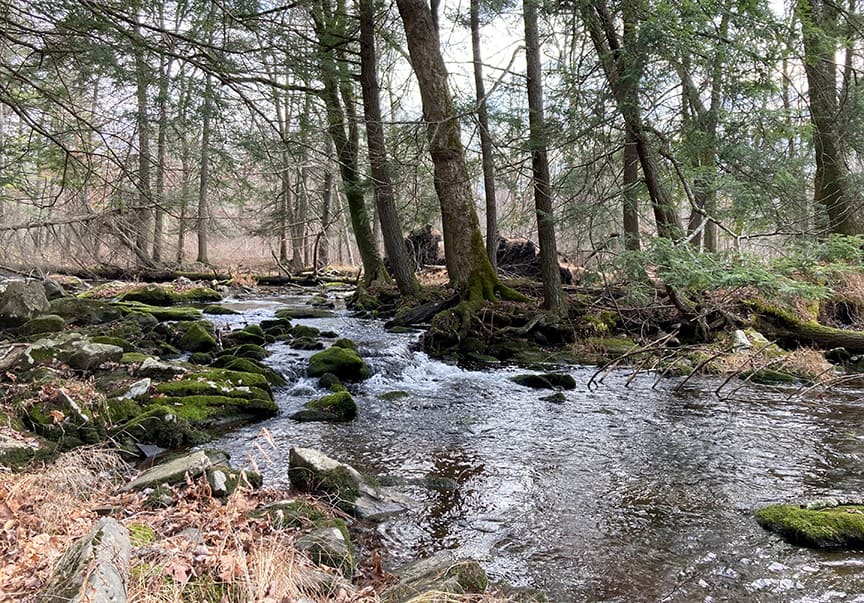
Woods & Water: BartoLacci land
“Woods and Water” is a new occasional feature focusing on the relation between land and water quality – and the conservation easements that help preserve our environment in the Brodhead watershed.

Landowner Bart Bartolacci and his wife, Vivian, chose to conserve the property in perpetuity, with a conservation easement.
Making a gift to the future
By Carol Hillestad
With his chocolate lab, Annie, gallivanting in the lead, Bart Bartolacci is showing me around his 40-acre private preserve along Stony Run in Price Township.
He’s already explained the backstory. It was the dearest wish of his wife, Vivian, to keep this land protected. She loved fly fishing here and at a nearby fishing club, and wanted to be sure this wild woodland would never become lawns and McMansions. Together, she and Bart made plans with a land trust to conserve the land permanently.
But conservation easements take time; fate intervened, and Vivian didn’t live quite long enough to see her wish fulfilled.
“She knew it was in the works. That gave her peace,” Bart says.
The woods are managed mostly by nature. Most storm-toppled trees lie where they fall, eventually becoming “nurse logs” that host lichens, ferns, saplings, and countless small creatures. Dry, brown curlicues are all that’s left of summer’s hay-scented fern, and wintergreen grows in the leaf litter beneath red stems of blueberries.
A long stretch of crystal-clear Stony Run meanders in and out of view. Its many braided strands come together as the water runs downstream into Brodhead Creek. From a wetland high on the Pocono Plateau, through this preserved land, it makes its way to the Delaware River and the Atlantic Ocean.
Nature is in charge here, but humans have left traces, too. Old stone walls mark boundary lines, and Bart points out a less common marker: a white oak, intentionally bent as a sapling, now grown into a conspicuous, L-shaped sentinel tree, about 130 years old — its purpose a mystery.
We circle around the perimeter, which abuts another 400-acre property that has also been protected by a land trust. In fact, several landowners in the area have conserved their property with conservation easements.
“Every conservation easement is different,” commented Louise Troutman, director of Pocono Heritage Land Trust, a local non-profit. “Some owners want to carve out an area in case children, grandchildren or a future owner wants to build a home one day. Others want to ensure there will be no future development at all.” Each easement is tailored to the property and the property owner’s wishes.
What conservation easements have in common is protecting land permanently. “You still own the land — you can sell it, for instance, or bequeath it to anyone you choose. The restrictions on development become part of the deed, so you, your heirs, or any other future owner will be bound by them,” Troutman says. As holder of the easement, part of a land trust’s job is to monitor the property and ensure it is protected “basically forever,” she adds.
The land remains private, but we all benefit when someone conserves land.
Natural forest land keeps drinking water from creeks and private wells safe and pure. It protects against floods and erosion. Neighboring property values tend to increase. Beautiful views remain undisturbed. Air quality stays high. Wildlife thrives on pure water, natural habitat, and room to roam.
We’re nearly back to where we started when Bart stops at an upright, head-high boulder. “When her illness got hard to bear,” Bart said, “this is where Vivian would come, to rest against this rock in the stillness.”
It’s good to know that thanks to two special people, this land will support healthy forest and pristine waters, as far as the future flows.
ABOUT CONSERVATION EASEMENTS
A conservation easement is a tool for conserving land. In our area, conserved land protects water quality and quantity, views, working farmland, forestland, and other public interests.
In fact, thousands of acres of farms, forests, scenic hillsides, historic landscapes, and town green spaces have been conserved with conservation easements. An easement is created by mutual agreement between a landowner and a private land trust. With conservation goals in mind, the easement limits certain uses of the land, while keeping the land in the owner’s control. Owners continue to use the land as they wish, within the constraints they agree on when establishing the easement.
Conservation easements don’t include public access unless the owner establishes that in the agreement. Conservation easements are designed to be perpetual. They become part of the deed to the land, and future owners will be bound by the terms.
- The property in this story is protected by Natural Lands Trust. For information, see natlands.org or call 610-353-5587.
- Pocono Heritage Land Trust was founded 35 years ago to protect environmentally important lands. Today, it protects more than 4,400 acres. For information, see phlt.org or call 570-424-1514.
- Brodhead Watershed Association was founded in 1989 to protect water from activities that degrade water quality and quantity. The best, cheapest and most effective way to keep drinking water safe and plentiful is to protect the woodlands our creeks and streams depend on.
Carol Hillestad is a hike leader and writer for Get Outdoors Poconos, a grant-funded series administered by Brodhead Watershed Association, supported by a grant from the William Penn Foundation.

Stony Run, a tributary of Brodhead Creek, starts high on the Pocono Plateau and runs mostly free and wild.

Trail markers like this “bent tree marker” can be found in the woodlands throughout our area.